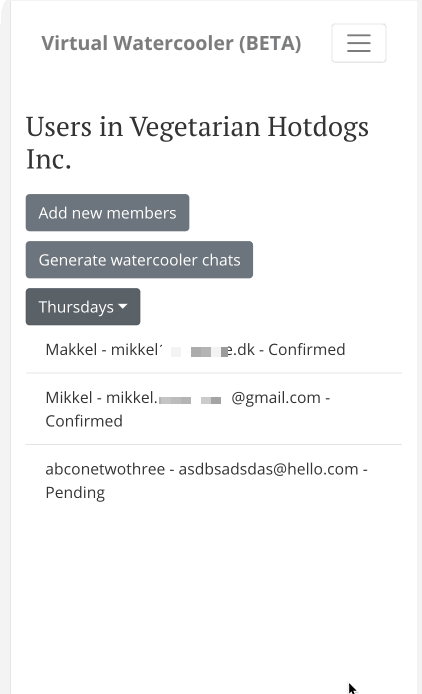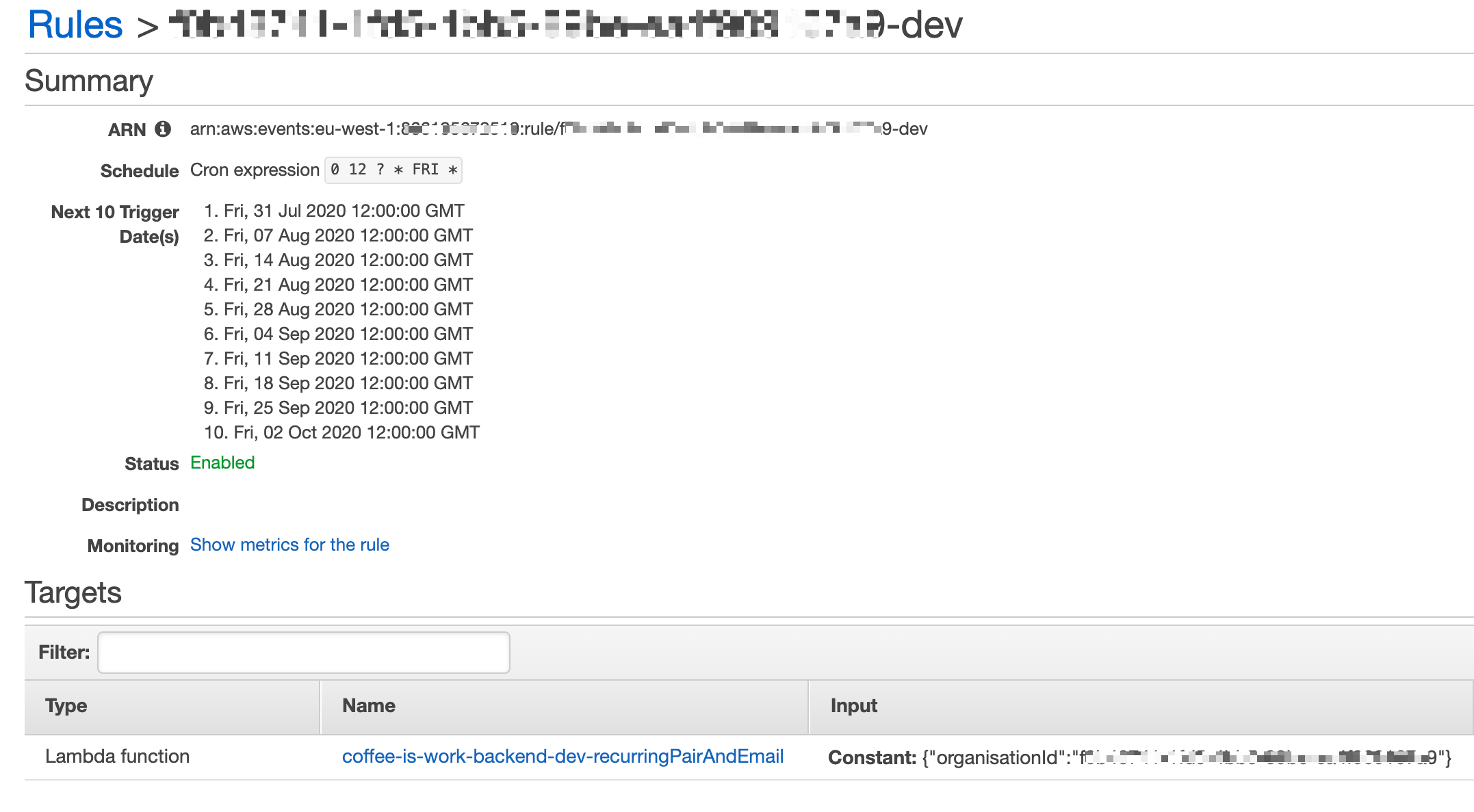Dynamically create CloudWatch Rules to let users schedule recurring actions
I recently needed to build a feature to let users set their own frequency for a recurring action. Specifically, I wanted to let the user decide how often my app should randomly pair members of their organisation and connect them via email.
I couldn’t find many resources on how to easily accomplish this with serverless on AWS, so thought I’d share my learnings and explain the approach I took.
In short, I have an API Gateway / Lambda endpoint which both:
-
Adds or updates a CloudWatch Rule with the desired frequency. This rule will then trigger a Lambda (when it’s time) which pairs and emails organisation members.
-
Adds or updates a ‘RecurrenceRule’ DynamoDB item (I store this here to make it easy to display to the user what their current setting is).
Visually, it could look e.g. like this with a simple dropdown:

In this post, I’ll explain how I implemented the backend side of this, using The Serverless Framework, API Gateway, Lambda, and CloudWatch.
Note: there may very well be better ways to achieve this. In fact, I’m secretly hoping that by sharing my approach here I will get some feedback to improve my solution, so please reach out if you’ve got ideas!
Write a ‘ManageRecurrenceRules’ Lambda
First, write a Lambda function which manages the recurrence rules. This is the one that will be triggered by users clicking in the dropdown example above.
We will need the clients for both DynamoDB and CloudWatch as well as an environmental variable:
const dynamoDb = new AWS.DynamoDB.DocumentClient();
const cloudWatch = new AWS.CloudWatchEvents();
const recurringPairAndEmailFunctionArn = process.env.RECURRING_PAIRANDEMAIL_LAMBDA_ARN;
Ignoring various other things you may want to do (e.g. I retrieve an organisationId from Cognito), we first need to construct a cron expression based on the POST request, e.g.:
const frequency = JSON.parse(event.body);
let scheduleExpression;
switch(frequency) {
case 'Fridays':
scheduleExpression = "cron(0 12 ? * FRI *)";
break;
case 'Every 5 Minutes':
scheduleExpression = "cron(0/5 * * * ? *)";
break;
case 'Daily':
scheduleExpression = "cron(0 12 * * ? *)";
break;
default:
// return an 'Invalid frequency' error to the user;
Next, we need to construct a unique rulename. I used an organisationId (which I get from an adminGetUser Cognito request) combined with the stage:
const ruleName = organisationId + "-" + process.env.STAGE;
Use putRule to create or update the rule and then use putTargets to add the desired target Lambda we want the rule to trigger in my case a Lambda function that pairs organisation members and email-intros each pair:
try {
await cloudWatch.putRule({
Name: ruleName,
ScheduleExpression: scheduleExpression
}).promise();
await cloudWatch.putTargets({
Rule: ruleName,
Targets: [
{
Id: organisationId,
Arn: recurringPairAndEmailFunctionArn,
Input: JSON.stringify({
organisationId: organisationId
}) // the rule will pass this Input to the Lambda when it triggers it
}
]
}).promise();
Note that I tell the rule to pass a custom Input to the Lambda target. This means that the target, in my case the ‘recurringPairAndEmailFunction’, can access the property directly from the event like this:
const orgId = event.organisationId;
Finally, still in the same ‘try/catch’ block, I add this rule to DynamoDB to easily display the currently selected frequency to the user:
const params = {
TableName: process.env.USERS_TABLE,
Item: {
PK: organisationId,
SK: "RecurrenceRule",
frequency: frequency
}
};
await dynamoDb.put(params).promise();
If all this goes well, we return a lovely 200 OK to the user 🎉
serverless.yml setup
Next, we need to define the API Gateway endpoint and pass the environmental variable to the Lambda (the recurringPairAndEmailFunctionArn used above). In the serverless.yml:
manageRecurrenceRules:
handler: manageRecurrenceRules.main
environment:
RECURRING_PAIRANDEMAIL_LAMBDA_ARN: arn:aws:lambda:${self:provider.region}:accountidgoeshere:function:${self:service}-${self:custom.stage}-recurringPairAndEmail
events:
- http:
path: rules
method: post
cors: true
authorizer: aws_iam
Note that the target Lambda, recurringPairAndEmail, is defined in the template as simply:
recurringPairAndEmail:
handler: recurringPairAndEmail.main
Next, we need to make sure that our Rules have the required permissions to invoke our Lambda. The below allows all rules for my account in this region to invoke the Lambda (which is probably too permissive):
resources:
- Resources:
RecurringPairAndEmailInvokePermission:
Type: AWS::Lambda::Permission
DependsOn: RecurringPairAndEmailLambdaFunction
Properties:
Action: lambda:InvokeFunction
Principal: events.amazonaws.com
SourceArn:
Fn::Sub: "arn:aws:events:${self:provider.region}:accountidgoeshere:rule/*"
FunctionName: arn:aws:lambda:${self:provider.region}:accountidgoeshere:function:${self:service}-${self:custom.stage}-recurringPairAndEmail
Finally, we need to ensure that our ‘ManageRecurrenceRules’ Lambda has permissions to add rules and targets, so we add the below in the provider section:
iamRoleStatements:
- Effect: "Allow"
Action:
- events:putRule
- events:putTargets
Aaand, that’s it!
Our users can now choose between Fridays, Daily or Every 5 Minutes as frequencies by making a POST request to the /rules path.
In CloudWatch, a rule will look something like this:

How can the solution be improved? Is this the ‘right’ way?
Now, back to my secret intention with this blog post… How can the solution be improved? Is this the ‘right’ way of implementing this feature?
How can I best work around the constraints on CloudWatch Rules, such as:
-
The per-region soft limit of 100 CW Rules.
-
The limit of 5 targets per rule (e.g. so having a rule for each frequency and adding organisations as Input probably isn’t the way either).
Thanks for reading and I hope to hear from you either here or on Twitter (@miksimal)!